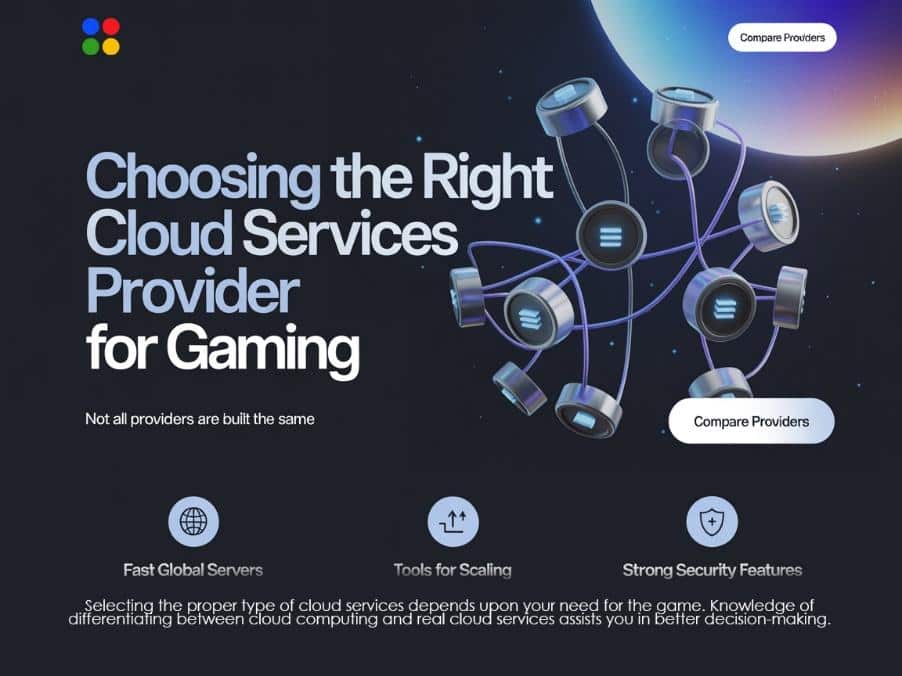The gaming world is growing fast. Millions of players log in each day and expect a seamless fast fun experience. Behind this rewarding on-line game lies a system that is running the whole show. It’s mostly built on cloud services.
Cloud services has become the lifeblood of gaming. They allow game developers to scale fast, reach players around the world, and increase user experience. From small indie games to the great massive multiplayer platforms, the cloud connects it all.
And just like how cloud tools help businesses stay flexible and online, they also protect gaming platforms.
Why Gaming Needs the Cloud
Today, gaming encompasses more than what is visible to the player. It also embraces whatever happens behind closed doors. With cloud services, games run smoother, scale easier, and reach more people.
Traditional game servers had limitations: they were physical machines, with rigid power and storage specifications. If too many players logged in, the game would lag or crash. With cloud infrastructure, the scenario changed.
Paid cloud services enable modern gaming in the following ways:
- Flexible scalability: Developers rent server power as required, meaning that they can scale up when more players come in and scale back down as traffic declines.
- Cost savings: Developers rent server guts and don’t buy expensive hardware.
- Faster performance: Better all-around load times and fewer crashes during peak traffic.
- Global reach: The ability to host games in multiple regions to reduce lag for players around the world.
- Business operations support: Everything from user account management to in-game purchases to data storage is seamlessly handled by cloud services for backend operations, just like IT cloud services for businesses.
Running a game equals running a business. With cloud tools, both keep everything organized and prepare for growth.
Key Benefits of Cloud Services for Gaming
Scalability for Multiplayer Games
Multiplayer games can be tricky. One day you have 1,000 players, the next day 100,000. With cloud tools, this isn’t a problem. Game servers can grow or shrink as needed. That’s called scaling.
This is possible because of cloud infrastructure, which allows horizontal and vertical scaling. You can add more servers or give more power to the ones you have. This way, your game stays smooth—even when player numbers jump.
Global Access and Low Latency
Players are everywhere. Someone from the U.S. might be playing with someone from Japan or Europe. Cloud platforms with global servers keep the game running fast for everyone.
Using services like Amazon cloud or Google’s cloud tools, developers can choose where to host their game. This reduces lag and gives all players a better experience.
Real-Time Updates and Patching
Games change fast. Whether it’s fixing bugs or adding new content, updates need to go live quickly. Cloud services let developers push changes in real-time. No need for long downtimes or manual installs.
This helps keep players happy. They get new content fast and issues get fixed quicker.
Reduced Hardware Requirements
Cloud gaming is on the rise. Players no longer need powerful computers or consoles. Games can now stream directly from the cloud.
With platforms like NVIDIA GeForce NOW or Xbox Cloud Gaming, a player with an average device can still enjoy high-quality games. This opens up access to more people and markets.
Enhancing User Experience Through Cloud Tools
Personalized Experiences Using Analytics
Cloud systems extract gameplay data in real time. This helps developers know what players like, what challenges they face, and what keeps them returning to play.
With these insights, games can be tweaked or customized. Maybe a player receives content in response to how they play. Or maybe in-game offers will change based on player progression.
Seamless Cross-Platform Play
People might play on different devices. Said console players will be others on PC or mobile. Developers can now allow cross-platform play with cloud-hosted game logic.
This means that Xboxes can play together with friends on Nintendo Switch. It keeps the barriers down, keeping more players connected.
Consistent Game Performance
No one likes lag or crashes. Cloud services guarantee reliable performance, even during server-heavy times. Smart resource management guarantees that the game stays responsive in the wake of all players.
Security Challenges and How to Address Them
The gaming platforms are often subjected to many attacks, where DDoS attacks, hacking, and account theft are common things. Therefore, a developer must always think in terms of security from the ground level of development.
Security strongholds run beyond the technological infrastructure. It includes threat monitoring, encrypting data, access control, etc.
Besides the fun of gaming, security and fairness are being looked into, and those Cloud services play a considerable role in that.
Choosing the Right Cloud Services Provider for Gaming
Not all providers are built the same. For gaming, you need:
- Fats global servers
- Tools for scaling
- High uptime guarantees
- Strong security features

Selecting the proper type of cloud services depends upon your need for the game. Knowledge of differentiating between cloud computing and real cloud services assists you in better decision-making.
In that case, if you have to handle player data, digital pickups, and in-game chats, then the one you choose should manage those elements with speed and care.
You should also check comparative analysis of providers, such as Amazon clouds, Google clouds, and so forth. Each has its strength.
Real-World Gaming Companies Using the Cloud
Big names in gaming already trust the cloud. Games like Fortnite, Minecraft, and Apex Legends use cloud platforms to stay online, support millions of players, and update fast.
These companies rely on cloud services for several reasons:
- Flexibility to scale resources during high traffic.
- Speed to roll out updates and patches across regions.
- Global access that allows players from different parts of the world to connect smoothly.
- Lower infrastructure costs without managing physical servers.
- Continuous performance even during massive in-game events.
Even smaller studios are following this path. Cloud tools give them the power to reach a global audience—without needing huge upfront investments or complex hardware setups.
Are You Ready to Level Up Your Game With the Cloud?
Cloud services are changing the way games are made and played. From better performance to safer platforms, the benefits are real.
If your game struggles with lag, downtime, or limited reach, now might be the time to switch. Whether you need better infrastructure, smarter backend tools, or stronger protection, the cloud has something to offer.
Understanding how services like infrastructure cloud, IT cloud systems, and cybersecurity all work together is key. With the right setup, you’re not just keeping up—you’re staying ahead.
If you’re ready to level up, now’s a great time to start.


